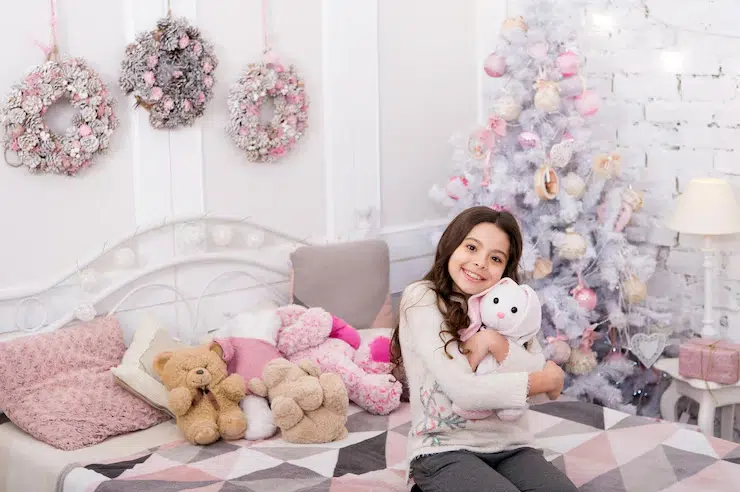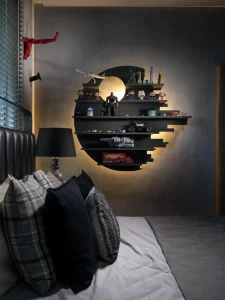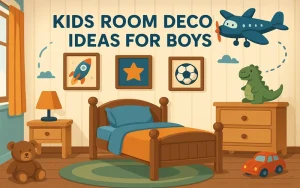
Kids Room Decor, Designing a child’s room is a delightful opportunity to spark creativity, foster comfort, and create a space where imagination thrives. Kids room decor is more than just aesthetics—it’s about crafting an environment that supports a child’s growth, reflects their personality, and adapts to their evolving needs. Whether you’re decorating a nursery, a toddler’s bedroom, or a tween’s hangout, this guide offers practical tips, creative ideas, and expert advice to help you create a magical and functional space. Written in clear, approachable language, this article covers everything from color schemes to storage solutions, ensuring your child’s room is both beautiful and practical.
Why Kids Room Decor Matters
A well-designed kids’ room is more than a place to sleep—it’s a sanctuary where children play, learn, and dream. Thoughtful kids room decor can:
-
Encourage Creativity: Vibrant colors, imaginative themes, and interactive elements stimulate a child’s imagination.
-
Promote Comfort: Cozy bedding, soft lighting, and ergonomic furniture create a nurturing environment.
-
Support Development: Age-appropriate decor, like learning tools or activity zones, fosters cognitive and emotional growth.
-
Reflect Personality: Personalized touches make the room feel uniquely theirs, boosting confidence and a sense of belonging.
-
Adapt to Growth: Flexible designs ensure the space evolves with the child, saving time and money.
With the right approach, kids room decor can transform a bedroom into a space that balances fun, functionality, and durability.
More Info: partners decoratoradvice .com
Key Elements of Kids Room Decor
To create a standout kids’ room, focus on these core components, each tailored to your child’s age, interests, and needs.
1. Color Schemes
Color sets the tone for kids room decor. Bright hues like yellow, turquoise, or coral energize young children, while softer pastels like lavender or mint green create a calming atmosphere for nurseries. For older kids, neutral bases (white, gray, or beige) with bold accents allow flexibility as tastes change. Consider these tips:
-
Use washable paint or wallpaper to handle messes.
-
Incorporate accent walls with removable decals for easy updates.
-
Balance bold colors with neutral furniture to avoid overwhelming the space.
2. Themes and Personalization
Themed decor brings a child’s interests to life. Popular themes include space adventures, woodland creatures, superheroes, or fairy tales. Involve your child in choosing a theme to make the room feel special. Personalize with:
-
Custom name signs or monogrammed pillows.
-
Wall art featuring their drawings or favorite characters.
-
Themed bedding and rugs that tie the room together.
For longevity, opt for subtle themes (e.g., a starry ceiling instead of a full astronaut mural) that can evolve with minimal changes.
3. Furniture Choices
Furniture should be safe, durable, and adaptable. Key pieces include:
-
Crib or Bed: Choose a convertible crib for babies or a loft bed with storage for older kids.
-
Desk or Activity Table: Support homework or crafts with a sturdy, appropriately sized desk.
-
Seating: Bean bags, floor cushions, or small chairs encourage reading and play.
-
Storage: Bookshelves, toy bins, and under-bed drawers keep clutter at bay.
Look for rounded edges, non-toxic materials, and multi-functional pieces (e.g., a bed with built-in shelves) to maximize space and safety.
4. Storage Solutions
Kids accumulate toys, clothes, and books quickly, making storage a priority. Creative kids room decor ideas for organization include:
-
Wall-mounted shelves for books and decor.
-
Stackable bins or baskets labeled for easy cleanup.
-
Ottomans or benches with hidden compartments.
-
Pegboards for hanging art supplies or accessories.
Teach kids to tidy up by making storage accessible and fun, like using colorful bins or low shelves.
5. Lighting
Lighting enhances both function and ambiance. Combine these types:
-
Ambient: Ceiling fixtures or chandeliers provide overall illumination. Choose whimsical designs like cloud-shaped lights.
-
Task: Desk lamps or bedside lights support reading and studying.
-
Accent: String lights, nightlights, or glowing decals add a magical touch.
Use dimmable lights for flexibility and ensure all fixtures are child-safe with cool-touch bulbs.
6. Textiles and Accessories
Soft furnishings add warmth and personality. Opt for:
-
Machine-washable rugs in playful patterns.
-
Blackout curtains for better sleep, with fun prints like stars or animals.
-
Cozy blankets and pillows in coordinating colors.
Accessories like wall decals, growth charts, or interactive chalkboard walls make kids room decor engaging and dynamic.
Age-Specific Kids Room Decor Ideas
Children’s needs change as they grow, so tailor decor to their developmental stage.
Nursery (0–2 Years)
Focus on safety and serenity:
-
Use soft, neutral colors to promote calm.
-
Install blackout curtains and a sound machine for better sleep.
-
Include a comfortable rocking chair for parents.
-
Add sensory elements like mobiles or textured rugs.
Toddler (2–5 Years)
Encourage exploration and independence:
-
Choose a low bed or toddler bed for easy access.
-
Create a play corner with a teepee or toy shelves.
-
Use bold colors and simple themes like animals or vehicles.
-
Add a small table for crafts or snacks.
School-Age (6–12 Years)
Support learning and self-expression:
-
Include a desk with storage for homework.
-
Use modular furniture that adapts to growth, like adjustable shelves.
-
Incorporate their hobbies, such as sports or music, into the decor.
-
Add a cozy reading nook with bookshelves and cushions.
Tween/Teen (13+ Years)
Balance style and functionality:
-
Opt for neutral colors with trendy accents like geometric patterns.
-
Provide a larger desk for studying or gaming.
-
Include a vanity or mirror for personal grooming.
-
Use wall space for posters or a bulletin board to showcase their personality.
Budget-Friendly Kids Room Decor Tips
Creating a dreamy kids’ room doesn’t have to break the bank. Try these cost-saving ideas:
-
DIY Projects: Paint furniture, create wall art, or sew curtains to save money.
-
Secondhand Finds: Shop thrift stores or online marketplaces for gently used furniture.
-
Repurpose Items: Turn crates into shelves or use mason jars for storage.
-
Focus on Impact: Invest in one statement piece (like a themed bed) and keep other elements simple.
-
Shop Sales: Look for discounts during back-to-school or holiday seasons.
With creativity, you can achieve stunning kids room decor on any budget.
Safety Considerations
Safety is paramount in kids room decor. Follow these guidelines:
-
Secure heavy furniture (dressers, bookshelves) to walls to prevent tipping.
-
Use cordless window treatments to avoid strangulation risks.
-
Choose non-toxic paints, finishes, and materials.
-
Ensure electrical outlets are covered and cords are out of reach.
-
Opt for flame-retardant bedding and rugs.
Regularly inspect the room for wear and tear, especially as kids grow and become more active.
Incorporating Learning and Play
A child’s room should inspire learning and creativity. Integrate these elements:
-
Learning Zones: Set up a chalkboard wall, magnetic board, or alphabet decals to encourage literacy and math skills.
-
Play Areas: Create a dress-up corner, puppet theater, or building block station to spark imagination.
-
Interactive Decor: Use glow-in-the-dark stars, world maps, or science-themed art to make learning fun.
These additions make kids room decor both educational and entertaining.
Sustainable and Eco-Friendly Decor
Eco-conscious parents can create a green kids’ room with these ideas:
-
Choose furniture made from sustainable materials like bamboo or reclaimed wood.
-
Use organic cotton or linen for bedding and curtains.
-
Opt for low-VOC paints to reduce harmful emissions.
-
Buy secondhand or upcycled decor to minimize waste.
-
Incorporate plants (safe for kids) to improve air quality.
Sustainable kids room decor is not only good for the planet but also teaches children about environmental responsibility.
Trends in Kids Room Decor for 2025
Stay ahead with these emerging trends:
-
Nature-Inspired Designs: Think forest murals, earthy tones, and wooden accents.
-
Bold Geometrics: Use hexagonal shelves or chevron rugs for a modern touch.
-
Tech Integration: Smart lighting or interactive wall panels appeal to tech-savvy kids.
-
Minimalist Boho: Combine neutral bases with textured textiles for a chic, timeless look.
-
Gender-Neutral Palettes: Move beyond pink and blue with greens, yellows, and grays.
These trends ensure your kids room decor feels fresh and stylish.
Real-World Inspiration
Parents across the globe are transforming kids’ rooms with creative ideas. For example, Emma, a mom from Seattle, used removable woodland decals and a tree-shaped bookshelf to create a nature-themed nursery for her toddler, costing under $300. Meanwhile, Raj, a dad in Chicago, built a loft bed with a slide for his 8-year-old, incorporating a desk underneath for homework. These stories show how kids room decor can be tailored to any space, budget, or vision.
Conclusion
Kids room decor is a chance to blend practicality with imagination, creating a space where children feel safe, inspired, and empowered. By focusing on color, furniture, storage, and personalization, you can design a room that grows with your child and reflects their unique spirit. Whether you’re on a tight budget or splurging on a dream design, the tips and ideas in this guide will help you craft a magical environment. Start planning today, involve your child in the process, and watch their room become a cherished haven for years to come.
Read More: lessinvest.com crypto
Frequently Asked Questions (FAQs)
1. How can I make kids room decor budget-friendly?
To save money, try DIY projects like painting furniture or creating wall art, shop secondhand for furniture, and focus on high-impact pieces like a themed bed while keeping other elements simple. Look for sales during holidays or back-to-school seasons.
2. What are some safe materials for kids room decor?
Use non-toxic paints, low-VOC finishes, and organic textiles like cotton or linen. Choose furniture with rounded edges and flame-retardant fabrics. Secure heavy items to walls and ensure all materials meet safety standards.
3. How do I choose a theme for my child’s room that won’t need frequent updates?
Opt for subtle themes, like a starry ceiling or neutral colors with accent decals, that can evolve with your child. Involve them in choosing elements they love, and use removable decor like wall stickers for easy updates.



